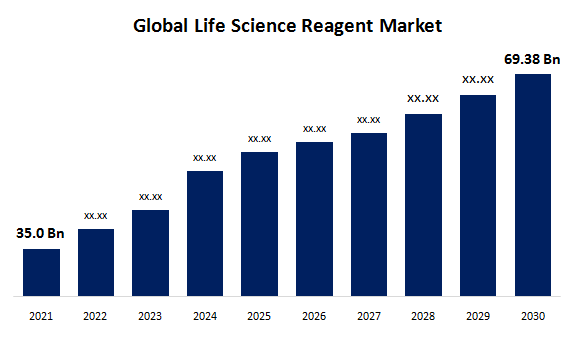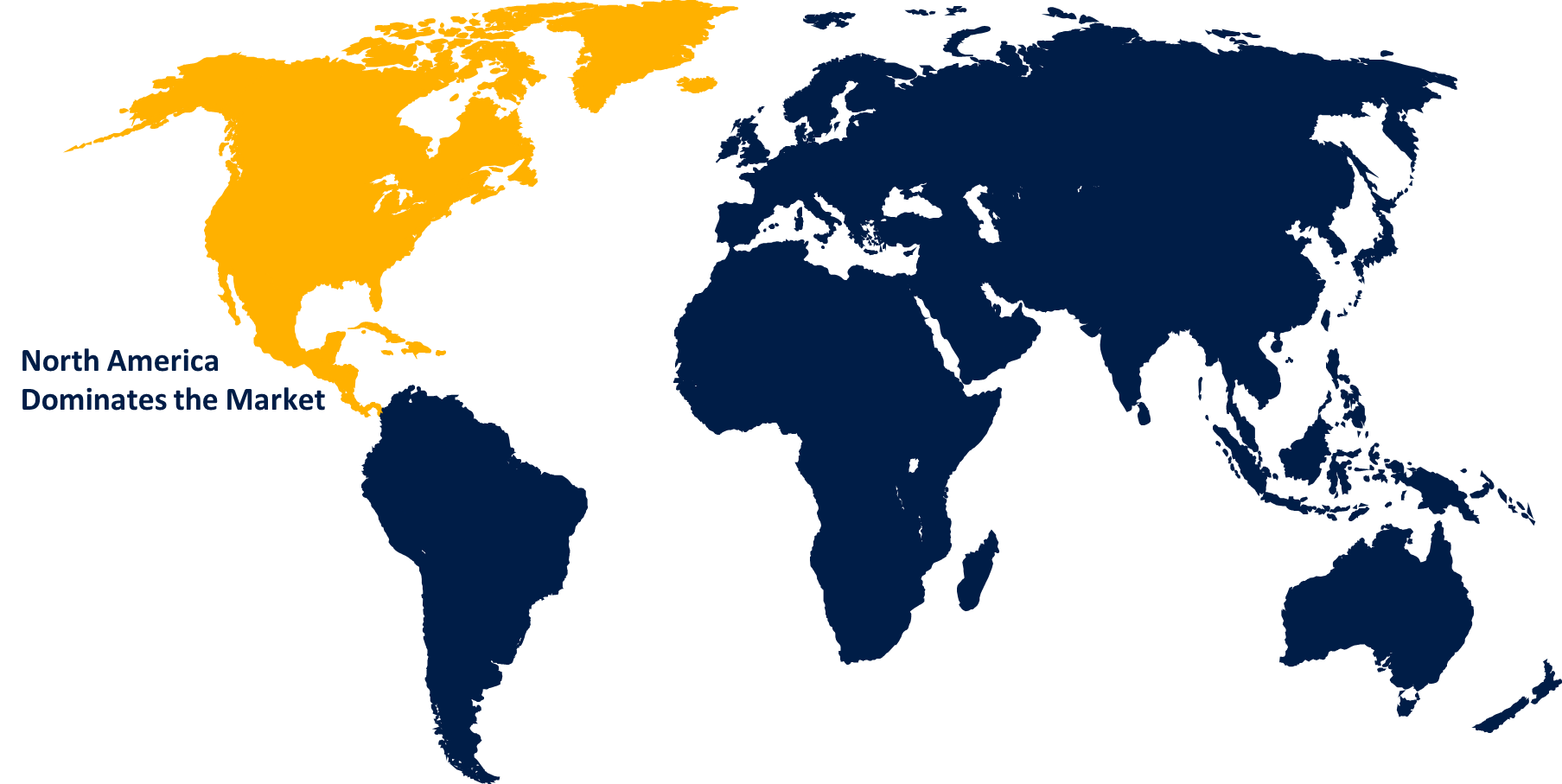Global Life Science Reagents Market Size, Share, and COVID-19 Impact Analysis, By Product Type (Cell and Tissue Culture Reagents, Chromatography Reagents, Clinical Chemistry Reagents, Immunoassay Reagents, Molecular Diagnostic Reagents, Microbiology Reagents, and Other Product Types), By End User (Hospitals and Diagnostic Laboratories, Academic and Research Institutes, and Other End Users),and By Region (North America, Europe, Asia-Pacific, Latin America, Middle East, and Africa), Analysis and Forecast 2021 - 2030.
Industry: HealthcareGlobal Life Science Reagents Market Insights Forecasts to 2030
- The global life science reagent market was valued at USD 35,000million in 2021.
- The market is growing at a CAGR of 7.9% from 2022 to 2030
- The global life science reagents market is expected to reach USD 69,384million by 2030
- Asia-Pacific is expected to grow the fastest during the forecast period

Get more details on this report -
The Global Life Science Reagents Market is expected to reach USD 69,384million by 2030, at a CAGR of 7.9% during the forecast period 2022 to 2030. The life science reagents market has grown due to the increasing number of Life Science Research Institutes.
Market Overview
Pharmaceutical, biotechnology, life science, and healthcare sectors all depend on life science reagents. Due to the rise in the use of life science reagents in vitro diagnostics for the diagnosis of numerous chronic and infectious diseases, the global market for life science reagents is anticipated to experience rapid growth during the forecast period. Reagents from the life sciences are also used to design treatments and assess how well they are working. Governments and private companies are projected to increase their funding for pharmaceutical R&D, which will aid in the development of new goods and technology.
The increased frequency of infectious disorders and technical developments in the life sciences and biotechnology industries are some of the reasons for boosting market expansion. Viruses, parasites, and other pathogenic microbes are to blame for the high occurrence of infectious disorders. These illnesses can be passed from one person to another either directly or indirectly. If precautions are not taken, they are easily spread and highly transmittable. In many undeveloped and developed nations, these diseases can be fatal due to a lack of healthcare infrastructure and resources. Salmonella bacteria is thought to be responsible for over 1.35 million infections, 26,500 hospitalizations, and 420 fatalities annually in the United States, according to a CDC report from February 2022.The country's healthcare system is burdened by a high number of infectious infections each year. As a result, the need for diagnostic tools is at an all-time high, which will drive up the market.
The increased demand for life science reagents is directly impacted by the rising occurrence of infectious diseases including Zika, Dengue, and HIV. According to data released by HIV.gov in June 2021, 34,800 new HIV infections occurred in 2019 at a rate of 12.6, making up around 1.2 million people living with the disease in the United States (per 100,000 people). This means that the country has a high incidence of HIV, raising demand for its diagnostic products, which will drive the market.
Global Life Science Reagents Market Report Coverage
| Report Coverage | Details |
|---|---|
| Base Year: | 2021 |
| Market Size in 2021: | USD 35,000 Million |
| Forecast Period: | 2022-2030 |
| Forecast Period CAGR 2022-2030 : | 7.9% |
| 2030 Value Projection: | USD 69,384 Million |
| Historical Data for: | 2019-2020 |
| No. of Pages: | 190 |
| Tables, Charts & Figures: | 112 |
| Segments covered: | By Product Type, By End-User |
| Companies covered:: | Agilent Technologies, Becton, Dickinson and Company, F. Hoffmann-La Roche AG, Bio-Rad Laboratories, Inc., Danaher Corporation, Illumina, Inc., Thermo Fisher Scientific, Inc, QIAGEN, Merck KGaA, Shimadzu Corporation, Hitachi, Ltd., Bruker, Oxford Instruments plc, and Zeiss International |
| Growth Drivers: | The life science reagents market has grown due to the increasing number of life science research institutes. |
| Pitfalls & Challenges: | Recent market developments and competitive strategies such as expansion, product launch and development, partnership, merger, and acquisition have been included to draw the competitive landscape in the market. |
Get more details on this report -
Report Coverage
This research report categorizes the market for global life science reagents based on various segments and regions, forecasts revenue growth, and analyzes trends in each submarket. The report analyses the key growth drivers, opportunities, and challenges influencing the global life science reagent market. Recent market developments and competitive strategies such as expansion, product launch and development, partnership, merger, and acquisition have been included to draw the competitive landscape in the market. The report strategically identifies and profiles the key market players and analyses their core competencies in each global life science reagent market sub-segments.
Segmentation Analysis
- In 2021, the immunoassay reagents segment dominated the market with the largest market share of 39% and market revenue of 13,650 million.
Based on the product type, the global life science reagent market is categorized into Cell and Tissue Culture Reagents, Chromatography Reagents, Clinical Chemistry Reagents, Immunoassay Reagents, Molecular Diagnostic Reagents, Microbiology Reagents, and Other Product Types. In 2021, the immunoassay reagentssegment dominated the market with the largest market share of 39% and market revenue of 13,650million. The most often-used diagnostic method in hospitals and pathology labs is an immunoassay. Due to its precise results, high sensitivity, and simplicity of use, the immunoassay approach is growing in popularity as a diagnostic tool.
- In 2021, the hospitals and diagnostic laboratories segment accounted for the largest share of the market, with 40% and a market revenue of 14,000million.
Based on the end-user, the life science reagent market is categorized into Hospitals and Diagnostic Laboratories, Academic and Research Institutes, and Other End Users. In 2021, the hospitals and diagnostic laboratoriessegment accounted for the largest share of the market, with 40% and a market revenue of 14,000million. In order to understand the epidemiology of the disorders, researchers are also using reagents, which will accelerate the segment's growth. Additionally, there has been a sharp rise in the use of life science reagent products used in testing for suspected COVID-19 patients in hospitals around the world, which has had a favorable impact on the growth of the market as a whole.
Regional Segment Analysis of the Life Science Reagent Market
- North America (U.S., Canada, Mexico)
- Europe (Germany, France, the U.K., Italy, Spain, Rest of Europe)
- Asia-Pacific (China, Japan, India, Rest of APAC)
- South America (Brazil and the Rest of South America)
- The Middle East and Africa (UAE, South Africa, Rest of MEA)

Get more details on this report -
North America emerged as the largest market for the global life science reagent market, with a market share of around 35% and 35,000million of the market revenue in 2021.
- In 2021, North America emerged as the largest market for the global life science reagent market, with a market share of around 35% and 35,000million of the market revenue. Due to the greater frequency of infectious diseases, rising prevalence, and aging population in this area. Incidence rates for other chronic diseases, such as cancer, are likewise high in the US. According to the American Cancer Society's 2022 forecast, there will likely be 1.9 million new cancer diagnoses and 609,360 cancer-related deaths in 2022. One of the main causes of death and disability in North America is these diseases.
- The Asia-Pacific market is expected to grow at the fastest CAGR between 2021 and 2030, due to the massive patient population and increase in healthcare investment in nations like China and India.
Competitive Landscape
The report offers the appropriate analysis of the key organizations/companies involved within the global life science reagents market along with a comparative evaluation primarily based on their product offering, business overviews, geographic presence, enterprise strategies, segment market share, and SWOT analysis. The report also provides an elaborative analysis focusing on the companies' current news and developments, including product development, innovations, joint ventures, partnerships, mergers & acquisitions, strategic alliances, and others. This allows for the evaluation of the overall competition within the market.
List of Key Market Players:
- Agilent Technologies
- Becton, Dickinson and Company
- F. Hoffmann-La Roche AG
- Bio-Rad Laboratories, Inc.
- Danaher Corporation
- Illumina, Inc.
- Thermo Fisher Scientific, Inc
- QIAGEN
- Merck KGaA
- Shimadzu Corporation
- Hitachi, Ltd.
- Bruker
- Oxford Instruments plc
- Zeiss International
Key Target Audience
- Market Players
- Investors
- End-users
- Government Authorities
- Consulting And Research Firm
- Venture capitalists
- Third-party knowledge providers
- Value-Added Resellers (VARs)
Some of the Key Developments:
- In June 2022,Exothera SA announced a partnership with LogicBio Therapeutics and Polyplus-transfection SA for the creation of a highly scalable AAV production platform with a capacity of 200 L to 2,000 L. This partnership will begin.
- In April 2022, The in-vitro diagnostic Lumipulse Presto iTACT Tacrolimus was introduced by H.U. Group Holdings Inc. and its fully-owned subsidiary Fujirebio Holdings, Inc. This reagent was created especially for the Lumipulse L2400 fully automated chemiluminescence enzyme immunoassay system.
Market Segment
This study forecasts global, regional, and country revenue from 2019 to 2030. Spherical Insights has segmented the global life science reagent market based on the below-mentioned segments:
Global Life Science Reagents Market, By Product Type
- Cell and Tissue Culture Reagents
- Chromatography Reagents
- Clinical Chemistry Reagents
- Immunoassay Reagents
- Molecular Diagnostic Reagents
- Microbiology Reagents
- Other Product Types
Global Life Science Reagents Market, By End-User
- Hospitals and Diagnostic Laboratories
- Academic and Research Institutes
- Other End Users
Global Life Science Reagents Market, Regional Analysis
- North America
- US
- Canada
- Mexico
- Europe
- Germany
- Uk
- France
- Italy
- Spain
- Russia
- Rest of Europe
- Asia Pacific
- China
- Japan
- India
- South Korea
- Australia
- Rest of Asia Pacific
- South America
- Brazil
- Argentina
- Rest of South America
- Middle East & Africa
- UAE
- Saudi Arabia
- Qatar
- South Africa
- Rest of the Middle East & Africa
Frequently Asked Questions (FAQ)
-
What is the market size of the Life Science Reagent market?As per Spherical Insights, the size of the Life Science Reagent market was valued at USD35,000million in 2022 to USD69,384million by 2030.
-
What is the market growth rate of the Life Science Reagent market?The Life Science Reagent market is growing at a CAGR of 7.9%from 2022 to 2030.
-
Which country dominates the Life Science Reagent market?North America emerged as the largest market for Life Science Reagent.
-
Who are the key players in the Life Science Reagent market?Key players in the Life Science Reagent market areAgilent Technologies, Becton, Dickinson and Company, F. Hoffmann-La Roche AG, Bio-Rad Laboratories, Inc.,Danaher Corporation, Illumina, Inc., Thermo Fisher Scientific, Inc, QIAGEN, Merck KGaA,Shimadzu Corporation, Hitachi, Ltd., Bruker, Oxford Instruments plc, and Zeiss International.
-
Which factor drives the growth of the Life Science Reagent market?Growth in Prevalence of Chronic and Infectious Diseasesis expected to drives the market's growth over the forecast period.
Need help to buy this report?